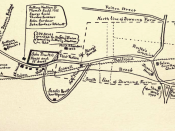The Witchcraft Hysteria
^^^^^^^^^^^^^^^^^^^^^^^
In 1692, in Salem Massachusetts, the superstition of witches existed
in a society of strong Christian beliefs. Anybody who acted out of the
ordinary was accused of being a witch and then the accuse would actually be
forgiven if the blamed their accusations on another individual. This was the
main idea of a play entitled, The Crucible by Arthur Miller. In this play a
group of young girls act up and are then accused of being witches. These
girls then blame other people in order to get out of trouble and even pretend
to be 'bewitched' in front of the court during a trial. This leads into the
deaths of some innocent people who were accused and automatically found guilty.
I believe, in many ways the people of Salem were responsible for the witch
hysteria.
The person with the most influence was the character, Abigail.
Abigail had an affair with a man by the name of John Proctor. Proctor broke
contact with Abigail and spent time and interest in his wife, Elizabeth.
Abigail gets jealous because of this and Abigail, a few other girls, and a
servant from the Caribbean named Tituba dance around in a order that they
believe it will kill Proctor's wife. Rev. Parris, Abigail's uncle, sees this
and reports it. When Abigail is questioned about this, she denies everything
and doesn't tell the truth about what really happened. The news of her and
the other girl's strange actions gets around and the hysteria starts.
Without Abigail's superstition, and her fear or telling the truth, I think
the events in The Crucible wouldn't have gotten as serious as they did or
even started.
John Proctor was another catalyst to the witch hysteria in Salem.
John Proctor has an affair with...


